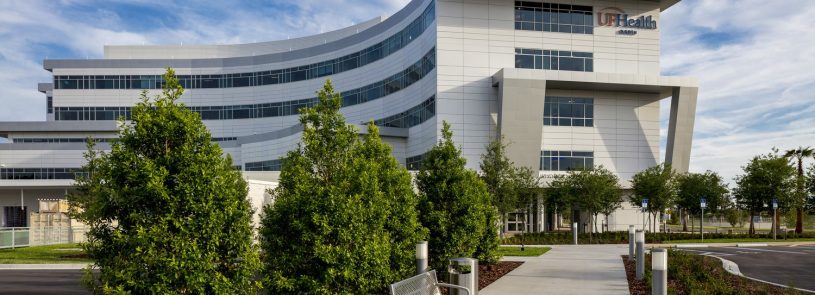Enhance hospital security through CPTED principles and De-escalation by Design

Fourth in a series of excerpts from the IMEG executive guide, “The Importance of Healthcare Resiliency: Preparing Your Hospital for a Crisis.”
By Ryan Searles
One of the most effective ways to increase a hospital’s physical security without creating an overly institutionalized aesthetic is by leveraging architectural elements to create secure environments. These strategies are called Crime Prevention Through Environmental Design (CPTED). Here’s how you can incorporate them — as well as other strategies — into your exterior and hospital entrance design.
Restrict the access points to the building. Designated, specific entrances for public access allows for easier monitoring and allows for secure visitor screening. Utilizing vegetation and various architectural elements can help drive people away from entrances you don’t want them to use and toward your main entrance.
Separate visitor and employee parking lots. Keep public access points separate from employee access points. By establishing a perimeter boundary for an employee parking lot, you can create a level of protection within the parking area so staff can move back and forth to their vehicles safely.
Utilize effective parking lot lighting. More than brightly lit parking lots, you need evenly lit parking lots. When lighting is too bright in some areas, it can have the effect of making other areas seem darker. Instead of using big, bright lights, use smaller, more frequent lights that have a high level of distribution.
Create vehicular boundaries. Since pedestrian traffic needs to be protected from vehicular traffic, creating a clear separation between the two can minimize incidents. For example, instead of just a crosswalk, consider using pavement changes, lighting changes, and rumble strips to draw attention to the separation.
Limit access to ambulance delivery areas. Separating the ambulance delivery area from the public emergency entrance will limit confusion and ensure an intruder isn’t gaining access to your hospital through a vulnerable and often chaotic area. This can be as simple as using additional vegetation or barriers.
Consider how you will handle after-hours traffic. It’s not uncommon for hospitals to have all after-hours traffic enter through the emergency department. While this is a fine solution, in order to make this a safe option, you may need to consider additional lighting and protective barriers.
Utilize glass vestibules as boundaries for secure entry. You can increase entrance security by creating a glass vestibule to act as an additional set of doors necessary to gain entry. Depending on the location of your hospital and your risk for gun violence, you could consider using bulletproof glass.
Make emergency departments escapable. To protect your employees working in admitting and waiting areas, where tempers can flair, create safe points and escapable options in case they feel threatened. For instance, have an additional exit behind the desk through which the employee can slip out if threatened.
Finally, consider De-escalation by Design, a security concept that creates spaces that are safe, calm, and therapeutic and is particularly effective for behavioral health units and emergency departments. The goal is to defuse situations in advance so staff rarely have to resort to conflict resolution and crisis intervention.
To learn more about this topic, read the IMEG executive guide, “The Importance of Healthcare Resiliency: Preparing Your Hospital for a Crisis.” For summaries of other topics in the guide, read:
- Resilience in healthcare: Five key areas for reducing risk during a disaster
- 3 questions to help define the structural integrity of your hospital
- 4 key areas of MEP resilience reduce healthcare facility risk during a natural disaster
- Prepare for mass casualty events and infectious outbreaks
- Improve healthcare cyber security with holistic approach to technology design
- Bonus: 10 key areas for hospital disaster preparedness












